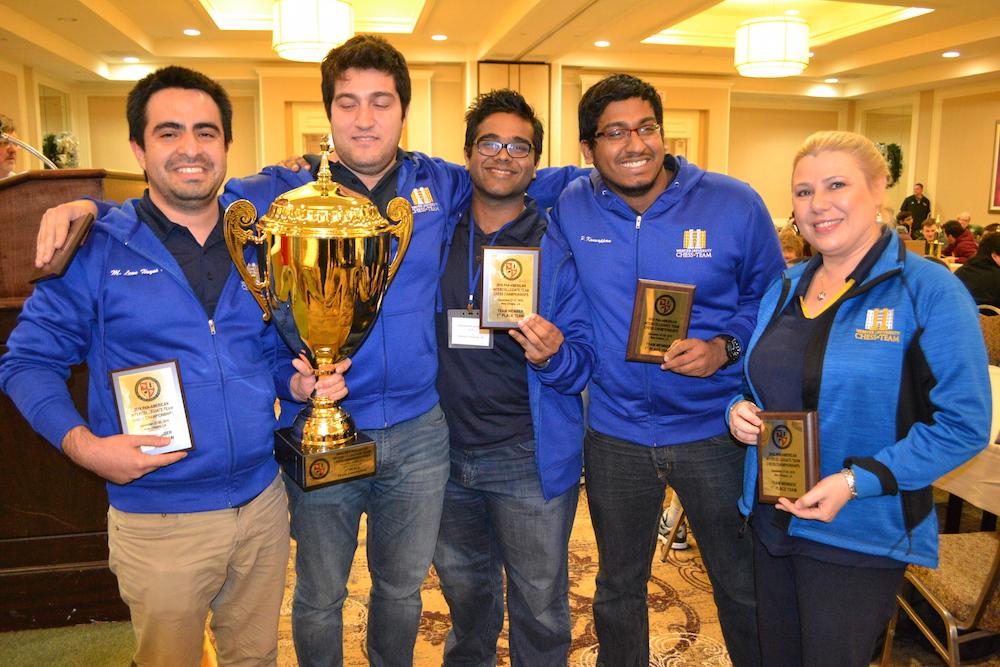
Webster Doubles Up At Pan-Ams
For the second year in a row, the "B" team from Webster University beat the "A" team at the Pan-American Intercollegiate Team Chess Championship.
Unlike 2015, the second team eclipsing the first squad wasn't necessarily bad news, as the two quartets finished tied for first atop the tables. Last year's Texas Tech squad won with 5.0/6, but this time the twin teams from the dominant collegiate chess program tied with 5.5/6.
This year's tournament took place at the close of 2016 in Kenner, Louisiana, just outside New Orleans.
Who did each team draw? Each other, in round five. The "B" team edged the "A" team on tiebreaks the next morning to be the official champion.
Photo above, courtesy Al Lawrence: Winning Webster "B" Team members (l. to r.) GMs Manuel Leon Hoyos, Vasif Durarbayli, Ashwin Jayaram, Priyadharshan Kannappan, coach Susan Polgar.
In 2012, two Webster teams also tied for first, but that year they were joined by three other schools. Webster has now won top honors in the premier college tournament in the western hemisphere in four of the five years of their chess program's existence. They still need six more Pan-Am wins to equal the shared record of ten wins by University of Maryland, Baltimore County (UMBC) and University of Texas at Dallas (UTD).

Webster avoided becoming King Solomon in round five. Instead of killing one's chances to buffer the other's, they split the point and both remained alive for a shot at first. (Photo: Paul Truong)
After their mutual draw versus one another in round five (which was an actual fight with two decisive games), Webster "B" took on UTD in the final round. The "A" team matched up with University of Texas at Rio Grande Valley, who lost the title on tiebreaks last year.
The second team won a little more convincingly, 3-1, while the top group suffered an individual game loss and needed an underperfoming GM Ray Robson to bail them out to win 2.5-1.5.
Back to the winning team, top board GM Vasif Durarbayli barely had time for the beignets to get hot before accepting GM Gil Popilski's handshake. His win helped make up for Durarbayli losing their head-to-head game at the 2015 Millionaire Open.
If you thought that was brutal, Durarbayli's teammate on board four was not impressed. GM Manuel Leon Hoyos, the first Mexican player to cross 2600, must have been in an even bigger hurry to catch some jazz music. He won in 14 moves as Black without needing much calculation:
Hoyos was one of three players in the event to garner a tournament-best 5.5/6 individually. The others were IM Cemil Ali Marandi of Saint Louis University and GM Tanguy Ringoir of UMBC-A.
Board two was much tighter. Despite Webster's "A" team being the highest-rated squad, their top player, GM Le Quang Liem, could only draw on board one. Board two didn't get better as GM Ilya Nyzhnyk went down to a powerful attack by GM Andrey Stukopin.
Webster "A's" fourth board GM Alex Shimanov got things square again with a slower-brewing, but no less effective, attacking win over UT-RGV Cuban GM Carlos Hevia Alejano.
It all came down to board three, where longtime Gorlok Robson had been struggling with two draws against an NM and IM and a loss to another IM from his opening five games. All was forgiven, however, after he converted the game and the match win against GM Vladimir Belous.
The position and technique resembled Karpov-Gligoric from the 1973 Interzonal, or less precisely, pretty much every Karpov Ruy Lopez game from that decade. Robson was the king of "small moves" and prevention of counterplay:
Paul Truong said his four teams traveled on a chartered bus for 15 hours to attend. The "C" team also finished a respectable fifth, only a half-point off the pace.

The entire Webster team, with their hardware and with coach Susan Polgar (sixth from right). | Photo: Paul Truong.
Three other teams finished on 5.0/6. Saint Louis University, in their first year at the Pan-Ams, took third. Fourth was last year's champion Texas Tech, and as mentioned, Webster "C" took fifth.
By rule, the upcoming Final Four of College Chess (traditionally in April in New York City) cannot have multiple teams from the same university, so the four moving on will be: Webster (who can choose to field any four players they wish), Saint Louis, Texas Tech, and UTD (who tied for sixth but beat the University of Toronto on tiebreaks).
The full final team standings can be found here, and the final individual standings can be found here.

According to U.S. Chess College Chess Committee Chair Al Lawrence, 60 teams competed overall from 35 federations and 33 universities. | Photo: Al Lawrence.


